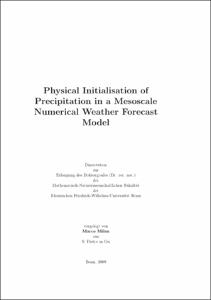Milan, Marco: Physical Initialisation of Precipitation in a Mesoscale Numerical Weather Forecast Model. - Bonn, 2010. - Dissertation, Rheinische Friedrich-Wilhelms-Universität Bonn.
Online-Ausgabe in bonndoc: https://nbn-resolving.org/urn:nbn:de:hbz:5N-20419
Online-Ausgabe in bonndoc: https://nbn-resolving.org/urn:nbn:de:hbz:5N-20419
@phdthesis{handle:20.500.11811/4530,
urn: https://nbn-resolving.org/urn:nbn:de:hbz:5N-20419,
author = {{Marco Milan}},
title = {Physical Initialisation of Precipitation in a Mesoscale Numerical Weather Forecast Model},
school = {Rheinische Friedrich-Wilhelms-Universität Bonn},
year = 2010,
month = mar,
note = {Short term quantitative precipitation forecast (QPF) is an important task for numerical weather prediction (NWP) models, particularly in summer. The increase of model resolution requires the understanding of the initiation and evolution of convection. Initialisation schemes based on radar derived precipitation fields can reduce the model forecast error in convective cases. Any improvement of QPF denotes a correct forecast of the dynamics and the moisture content of the atmosphere, thus upgrading QPF generically improves NWP forecast.
The method, which we call Physical initialisation Bonn (PIB), uses as the most important input the precipitation estimation from the German weather service (DWD) radar network and assimilates the data into the operational non-hydrostatic COSMO model. During the assimilation window, PIB converts the input data (radar precipitation and cloud top height from satellite data) into prognostic COSMO variables, which are relevant for the development of rain events. PIB directly adjusts vertical wind, humidity, cloud water, and cloud ice in order to force the model state towards the measurements. The most distinctive feature of the algorithm is the adjustment of the vertical wind profile in the framework of a simple precipitation generation scheme.
In a first study we performed an identical twin experiment with three convective cases. The consistency of PIB with the physics of the NWP model is proved using qualitative comparisons and quantitative evaluations (e.g. objective skill scores).
The performance of PIB, using real data, is investigated by applying the scheme to the whole month of August 2007, with three simulations every day, at 00, 08 and 16 UTC. Every simulation consists of two hours of data assimilation followed by seven hours of free forecast. The comparison with the Control run and with Latent heat nudging, the operational radar data assimilation scheme from the DWD, is also made. PIB succeeds in improving QPF for up to six hours. Its results are comparable to the forecast by LHN.
The sensitive of PIB to different assimilation windows is tested. An assimilation window of only 15 minutes is enough to provide the trigger for convection and to enhance the forecast quality. Thus PIB is much more time efficient than LHN and need much less observation values.},
url = {https://hdl.handle.net/20.500.11811/4530}
}
urn: https://nbn-resolving.org/urn:nbn:de:hbz:5N-20419,
author = {{Marco Milan}},
title = {Physical Initialisation of Precipitation in a Mesoscale Numerical Weather Forecast Model},
school = {Rheinische Friedrich-Wilhelms-Universität Bonn},
year = 2010,
month = mar,
note = {Short term quantitative precipitation forecast (QPF) is an important task for numerical weather prediction (NWP) models, particularly in summer. The increase of model resolution requires the understanding of the initiation and evolution of convection. Initialisation schemes based on radar derived precipitation fields can reduce the model forecast error in convective cases. Any improvement of QPF denotes a correct forecast of the dynamics and the moisture content of the atmosphere, thus upgrading QPF generically improves NWP forecast.
The method, which we call Physical initialisation Bonn (PIB), uses as the most important input the precipitation estimation from the German weather service (DWD) radar network and assimilates the data into the operational non-hydrostatic COSMO model. During the assimilation window, PIB converts the input data (radar precipitation and cloud top height from satellite data) into prognostic COSMO variables, which are relevant for the development of rain events. PIB directly adjusts vertical wind, humidity, cloud water, and cloud ice in order to force the model state towards the measurements. The most distinctive feature of the algorithm is the adjustment of the vertical wind profile in the framework of a simple precipitation generation scheme.
In a first study we performed an identical twin experiment with three convective cases. The consistency of PIB with the physics of the NWP model is proved using qualitative comparisons and quantitative evaluations (e.g. objective skill scores).
The performance of PIB, using real data, is investigated by applying the scheme to the whole month of August 2007, with three simulations every day, at 00, 08 and 16 UTC. Every simulation consists of two hours of data assimilation followed by seven hours of free forecast. The comparison with the Control run and with Latent heat nudging, the operational radar data assimilation scheme from the DWD, is also made. PIB succeeds in improving QPF for up to six hours. Its results are comparable to the forecast by LHN.
The sensitive of PIB to different assimilation windows is tested. An assimilation window of only 15 minutes is enough to provide the trigger for convection and to enhance the forecast quality. Thus PIB is much more time efficient than LHN and need much less observation values.},
url = {https://hdl.handle.net/20.500.11811/4530}
}






